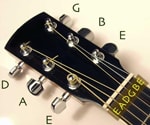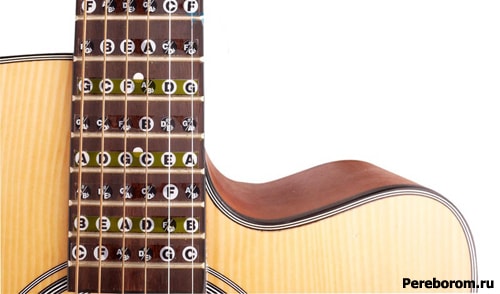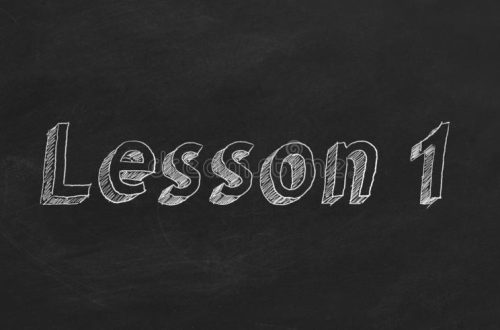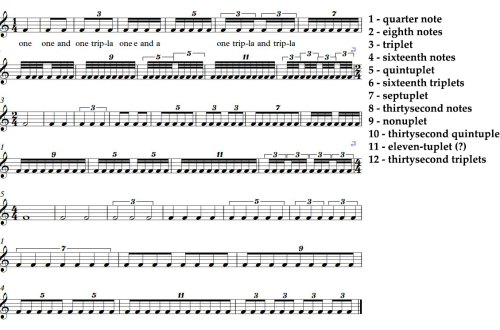
Notes on the fretboard of a guitar. 16 steps to study the location of notes on the fretboard.
Contents
- How to learn notes on the guitar?
- Why should I learn the location of the notes on the fretboard?
- Required basic knowledge
- Guitar sheet music
- Step by step study of the location of notes on the guitar
- The first day. Learning notes on the sixth string
- Second day. Learning notes on the fifth string
- Day three. Learning notes on the fourth string
- Day four. Learning notes on the third string
- Day five. Learning notes on the second string
- Day six. Learning the notes on the first string
- Day seven. Octave recognition. Finding the right notes
- Day eight. All notes on the fifth fret
- Day nine. All notes on the tenth fret
- Day ten. Memorize all notes A
- Day eleven. Memorize all notes B
- Day twelve. Memorize all the notes
- Day thirteen. Memorize all notes D
- Day fourteen. We remember all the notes E
- Day fifteen. Memorize all notes F
- Day sixteen. Memorize all G notes
- Should you use sheet music stickers on your guitar fretboard?
- Some Helpful Tips
How to learn notes on the guitar?
There are quite a few ways to do this, but the easiest is to just memorize and memorize them using some simplification measures. Otherwise, the process may take a long time, which will significantly stop your musical development. This article is dedicated to the systematization of learning notes on the guitar, and also contains a few simple steps that will help with this.
Why should I learn the location of the notes on the fretboard?

The answer to this is the same as to the question – why learn music at all? All music is made up of them, like a language is made up of letters, so without knowing the notes, you simply cannot come up with really interesting and complex compositions. Of course, you will be able to learn any composition by chords, but to improvise, compose beautiful solos, come up with interesting chord progressions – absolutely not. You won’t know when to play a particular note, or even where the right sound is. Knowing where a note is on the fretboard – or better yet, how it sounds – will allow you to freely play pieces of any level of complexity on the guitar.
Required basic knowledge
Note notation
In writing, they are marked with letters of the Latin alphabet from A to G. Accordingly, their meanings look like this:
- A – la;
- B – si (sometimes it can be referred to as H);
- C – to;
- D – re;
- E – mi;
- F – fa;
- G is salt.
In the following tutorial, we will use just such annotations for your convenience.
Notes on open strings

In standard tuning, the open strings on the guitar are built in a fourth to each other, except for the third and second – they build in a major third. Thanks to this, chords are clamped much easier, this makes it much easier to learn scales and pentatonic boxes. The notes on the open strings are in the following order from first to sixth – EBGDA E. This is called “standard tuning”. It is worth saying that almost all popular tunings do not change its structure much, and sometimes they simply omit the notes, maintaining the technical sequence.
What does sharp and flat mean

In modern music theory, few people use both of these concepts – rather, it is characteristic of students of music schools who studied classical theory. In general, it is possible to conditionally put an equal sign between these concepts, because sharps and flats mean “intermediate” – that is, semitones, or black keys on the piano. For example, after the note C, it is not D, but Db – D flat, or C #. Actually, in classical textbooks it is indicated that Flat is written when we go up the scale, and Sharp – down. However, this moment can be omitted, and the intermediate notes can be called as it is convenient for you – the concepts still mean the same thing.
Where flats and sharps are not used
Exactly in two keys – A minor and C major. In other situations, they are actively used by all musicians without exception.
Also , flats and sharps are missing between the notes E and F, as well as B and C. They are a semitone apart. Be sure to remember this – this aspect is quite important when improvising.
What is a natural series
In fact, the natural range is called the usual scale without raising and lowering steps. In it, all the notes go sequentially one after another in the classical major or minor order. This order is very important to know for guitar improvisation , since it is on it that it is built.
Guitar sheet music
Before proceeding directly to memorizing notes, take a look at this table, on which they are indicated up to the 12th fret. Why until the 12th? Because this is a whole octave, and after it the notes repeat in the same order, as if starting from zero. In this case, the twelfth is the zero fret.

Step by step study of the location of notes on the guitar
The first day. Learning notes on the sixth string
So, you should start with the lowest string on the guitar. In standard tuning, the notes are arranged as follows:

Second day. Learning notes on the fifth string
The next step is the fifth string. On it, the notes are arranged in this order.

Day three. Learning notes on the fourth string
Next is the fourth line. In the standard, the notes on it are

Day four. Learning notes on the third string
In the standard it looks like this

Day five. Learning notes on the second string
By default it looks like this

Day six. Learning the notes on the first string
For the standard tuning, the markup is as follows

As you can see, the notes are located exactly the same as on the sixth string.
Day seven. Octave recognition. Finding the right notes
First of all, it’s worth talking about the principles thanks to which you can quickly find an octave, and, starting from it, the desired note:
- A string clamped at the seventh fret will sound an octave to the open previous one. This applies to the strings from the sixth to the fourth, in the case of the second fret, it is necessary to clamp not the seventh, but the eighth.
- If you, for example, press the fifth fret on the sixth string, and the seventh fret on the fourth, then this will also be an octave. This applies to strings six through four, in the case when you hold the fourth and second or third and first, then move the top note one fret to the right.
Remember these two simple principles, and together with the tables above, you will easily find octaves for all the notes on the fretboard. This is very important in a matter of how to play a solo , since you will need to constantly find the tonic to return to the right place.
Day eight. All notes on the fifth fret
In standard guitar tuning, no note at the fifth fret is intermediate. Use this as a reminder to look for other sounds around the fretboard – just memorize their location and you can literally figure out where the note you need is on the go.

Day nine. All notes on the tenth fret
The same applies to notes at the tenth fret – in standard guitar tuning, none of them is intermediate. It can also serve as a kind of guide for you when playing.

Day ten. Memorize all notes A
In standard tuning, the note A is located on the following frets.

Day eleven. Memorize all notes B
Note B in standard tuning is located on the following frets

Day twelve. Memorize all the notes
In the standard, the note C is on these frets

Day thirteen. Memorize all notes D
This note is sounded by these frets

Day fourteen. We remember all the notes E
This note is represented by these frets

Day fifteen. Memorize all notes F
This note is on the following frets

Day sixteen. Memorize all G notes
She’s on these frets

Should you use sheet music stickers on your guitar fretboard?
Definitely yes, but only at first. This way, it will actually be easier for you to remember which note is which. However, do not cling to them – gradually remove them from the fretboard and try to memorize notes without them.

Some Helpful Tips
- As mentioned above – use stickers on the fretboard to remember the right notes;
- Train your ear – learn not only to remember the location of notes on the fretboard, but also how they sound in order to quickly find the right intonation by sound;
- Find all the intervals throughout the fretboard – this will help a lot in the game in the future;
- Remember what notes and how chords are built, so that later you can easily put them anywhere on the fretboard;
- Learn how major and minor scales are built, and try to build them from notes already remembered anywhere on the fretboard.





